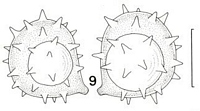|
 Clavaria echinonivosa Clavaria echinonivosa
BiostatusPresent in region - Indigenous. Endemic
Images (click to enlarge)
Caption: Fig. 9 Clavaria echino-nivosa, spores, TENN no. 43697. Scale bar=5µm. |
Article: Petersen, R.H. (1988). The clavarioid fungi of New Zealand. New Zealand Department of Scientific and Industrial Research, Bulletin 236: 170 pp. Wellington:.
Description: Fruit bodies up to 6 cm high, up to 3 mm thick, simple clubs, scattered to gregarious but not
cespitose, arising from small white mycelial patches, shining snow-white all over. Club
opaque, appearing waxy, equal to tapering somewhat upward; apex narrowly rounded. Stipe
silky-shiny, equal to tapering slightly downward; odour and taste negligible.
Tramal hyphae significantly inflated, of barrel-shaped cells often disarticulating in squash
mounts, thin-walled, hyaline, clampless; secondary septa rare; gloeoplerous hyphae not
observed. Subhymenium poorly developed. Basidia 40-45 µm long, broadly clavate,
clampless, (2)-4-sterigmate; contents multiguttulate when mature.
Spores 6.5-7.2 x 5.8-6.6 µm (E = 1.06-1.13; Em = 1.11; Lm = 6.95 µm), subglobose,
thin-walled, smooth to echinulate; contents uniguttulate at maturity; hilar appendix prominent,
papillate.
Notes: Corner's (1970) latest summary key to the taxa of Clavaria includes two taxa with spiny
spores in subg. Clavaria, both producing dark fruit bodies (C. atrofusca Vel., C.
asperulospora Atk.). I have added another dark fruiter, C. neonigrita Pet., but, to my
knowledge, no spiny-spored taxon has been reported to produce white fruit bodies with
clampless basidia. C. asterospora Pat. seems very similar by Corner's (1970) description, but
I find little reason to accept that the European C. asterospora is as Corner describes it from
Caribbean material, or that it belongs in subg. Holocoryne. I have too few data on which to
judge C. asterospora, but I am willing to propose C. echino-nivosa on the basis of its
geographic location alone. Only by proposing it as a new taxon will it receive attention by
mycologists, and the problem of the identity of C. asterospora be solved.
The hymenium of Clavaria echino-nivosa is hardly thickened. Basidia arise from knots of
very compact subhymenial hyphae, produce spores, and then quickly collapse, so relatively
few turgid basidia can be observed in the hymenium. By making mounts from the tip of the
club, however, the young basidia can be seen to lack the characteristic clamp of subg.
Holocoryne. Moreover, the tramal hyphae are not only inflated but short-celled and
unagglutinated, so the disarticulation of cells can be seen clearly.
Basidia are broad for their height, but so few basidia were observed in a condition favourable
for measurement that I hesitate to give such statistics.
|